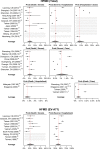Severity and burden of hand, foot and mouth disease in Asia: a modelling study
- PMID: 29564154
- PMCID: PMC5859810
- DOI: 10.1136/bmjgh-2017-000442
Severity and burden of hand, foot and mouth disease in Asia: a modelling study
Abstract
Background: Hand, foot and mouth disease (HFMD) affects millions of children across Asia annually, leading to an increase in implemented control policies such as surveillance, isolation and social distancing in affected jurisdictions. However, limited knowledge of disease burden and severity causes difficulty in policy optimisation as the associated economic cost cannot be easily estimated. We use a data synthesis approach to provide a comprehensive picture of HFMD disease burden, estimating infection risk, symptomatic rates, the risk of complications and death, and overall disability-adjusted life-year (DALY) losses, along with associated uncertainties.
Methods: Complementary data from a variety of sources were synthesised with mathematical models to obtain estimates of severity of HFMD. This includes serological and other data extracted through a systematic review of HFMD epidemiology previously published by the authors, and laboratory investigations and sentinel reports from Singapore's surveillance system.
Results: HFMD is estimated to cause 96 900 (95% CI 40 600 to 259 000) age-weighted DALYs per annum in eight high-burden countries in East and Southeast Asia, with the majority of DALYs attributed to years of life lost. The symptomatic case hospitalisation rate of HFMD is 6% (2.8%-14.9%), of which 18.7% (6.7%-31.5%) are expected to develop complications. 5% (2.9%-7.4%) of such cases are fatal, bringing the overall case fatality ratio to be 52.3 (24.4-92.7) per 100 000 symptomatic infections. In contrast, the EV-A71 case fatality ratio is estimated to be at least 229.7 (75.4-672.1) per 100 000 symptomatic cases. Asymptomatic rate for EV-A71 is 71.4% (68.3%-74.3%) for ages 1-4, the years of greatest incidence.
Conclusion: Despite the high incidence rate of HFMD, total DALY due to HFMD is limited in comparison to other endemic diseases in the region, such as dengue and upper respiratory tract infection. With the majority of DALY caused by years of life lost, it is possible to mitigate most with increased EV-A71 vaccine coverage.
Keywords: Epidemiology; Mathematical Modelling; Other Infection, Disease, Disorder, Or Injury; Paediatrics.
Conflict of interest statement
Competing interests: None declared.
Figures




Similar articles
-
Hand, Foot, and Mouth Disease in China: Modeling Epidemic Dynamics of Enterovirus Serotypes and Implications for Vaccination.PLoS Med. 2016 Feb 16;13(2):e1001958. doi: 10.1371/journal.pmed.1001958. eCollection 2016 Feb. PLoS Med. 2016. PMID: 26882540 Free PMC article.
-
[Analysis on epidemiological characteristics of enterovirus 71 cases of hand-foot-mouth disease based on the active monitoring in Guangdong Province in 2011-2015].Zhonghua Yu Fang Yi Xue Za Zhi. 2018 Jul 6;52(7):738-742. doi: 10.3760/cma.j.issn.0253-9624.2018.07.011. Zhonghua Yu Fang Yi Xue Za Zhi. 2018. PMID: 29996302 Chinese.
-
Surveillance for severe hand, foot, and mouth disease from 2009 to 2015 in Jiangsu province: epidemiology, etiology, and disease burden.BMC Infect Dis. 2019 Jan 22;19(1):79. doi: 10.1186/s12879-018-3659-7. BMC Infect Dis. 2019. PMID: 30669973 Free PMC article.
-
Is a multivalent hand, foot, and mouth disease vaccine feasible?Hum Vaccin Immunother. 2015;11(11):2688-704. doi: 10.1080/21645515.2015.1049780. Epub 2015 May 26. Hum Vaccin Immunother. 2015. PMID: 26009802 Free PMC article. Review.
-
Enterovirus-Associated Hand-Foot and Mouth Disease and Neurological Complications in Japan and the Rest of the World.Int J Mol Sci. 2019 Oct 20;20(20):5201. doi: 10.3390/ijms20205201. Int J Mol Sci. 2019. PMID: 31635198 Free PMC article. Review.
Cited by
-
Vaccination coverage estimates and utilization patterns of inactivated enterovirus 71 vaccine post vaccine introduction in Ningbo, China.BMC Public Health. 2021 Jun 10;21(1):1118. doi: 10.1186/s12889-021-11198-6. BMC Public Health. 2021. PMID: 34112128 Free PMC article.
-
Structural insight into EV-A71 3A protein and its interaction with a peptide inhibitor.Virol Sin. 2023 Dec;38(6):975-979. doi: 10.1016/j.virs.2023.09.004. Epub 2023 Sep 26. Virol Sin. 2023. PMID: 37757951 Free PMC article.
-
Health-Related Quality of Life and Economic Burden Among Hospitalized Children with Hand, Foot, and Mouth Disease: A Multiregional Study in China.Pharmacoecon Open. 2024 May;8(3):459-469. doi: 10.1007/s41669-023-00468-1. Epub 2024 Jan 9. Pharmacoecon Open. 2024. PMID: 38195850 Free PMC article.
-
Forecasting HFMD Cases Using Weather Variables and Google Search Queries in Sabah, Malaysia.Int J Environ Res Public Health. 2022 Dec 15;19(24):16880. doi: 10.3390/ijerph192416880. Int J Environ Res Public Health. 2022. PMID: 36554768 Free PMC article.
-
Incidence trend and disease burden of seven vaccine-preventable diseases in Shandong province, China, 2013-2017: Findings from a population-based observational study.Vaccine X. 2022 Feb 5;10:100145. doi: 10.1016/j.jvacx.2022.100145. eCollection 2022 Apr. Vaccine X. 2022. PMID: 35243321 Free PMC article.
References
LinkOut - more resources
Full Text Sources
Other Literature Sources
